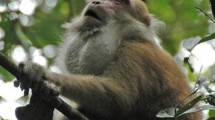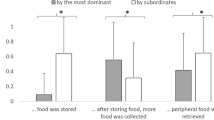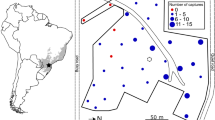Abstract
In primate species with unidirectional dominance relationships, rank order restricts the access of nondominant females to clumped resources. However, females might attempt to bypass the rank order by reaching feeding sites before the highest ranking individuals (early arrival tactic) when there are net benefits. We therefore analyzed the order of arrival to the feeding site of the adult members of a captive group of long-tailed macaques. We used 2 experimental conditions that differed in the spatial distribution of a fixed amount of food (large vs. small patch). Though each condition induced contest competition, it was stronger in the small-patch condition. Arrival order does not correlate with dominance rank in either experimental condition. The α-male and α-female reached the feeding site 10–30 s after the beginning of the test. Some females seized on opportunities to reach the feeding site before them, especially in the large-patch condition. They used the early arrival tactic when the risks of aggression were relatively low, which subjects accomplished either by being dominant or by being nondominant but tolerated by the α-male. Social tolerance may provide individuals with an alternative means to obtain resources. In sum, variation in food abundance and distribution may affect the extent to which rank order determines order of arrival to feeding sites. A higher rank may confer priority in the choice of tactics, but not necessarily priority of access to the resources themselves.





Similar content being viewed by others
References
Altmann, J. (1974). Observational study of behaviour: Sampling methods. Behaviour, 49, 227–267.
Barta, Z., & Giraldeau, L. A. (1998). The effect of dominance hierarchy on the use of alternative foraging tactics: A phenotype-limited producing-scrounging game. Behavioral Ecology and Sociobiology, 42, 217–223.
Bélisle, P., & Chapais, B. (2001). Tolerated co-feeding in relation to degree of kinship in Japanese macaques. Behaviour, 138, 487–509.
Brennan, J., & Anderson, J. R. (1988). Varying responses to feeding competition in a group of rhesus monkeys (Macaca mulatta). Primates, 29, 353–360.
Chapais, B. (1986). Why do adult male and female rhesus monkeys affiliate during the birth season? In R. G. Rawlins, & M. J. Kessler (Eds.), The Cayo Santiago macaques: History, behavior and biology (pp. 172–200). Albany: State University of New York Press.
Chapais, B. (1995). Alliances as means of competition in primates: Evolutionary, developmental, and cognitive aspects. Yearbok of Physical Anthropology, 38, 115–136.
Chapais, B., & Gauthier, C. (2004). Juveniles outrank higher-born females in groups of long-tailed macaques with minimal kinship. International Journal of Primatology, 25, 429–447.
Deutsch, J. C., & Lee, P. C. (1991). Dominance and feeding competition in captive rhesus monkeys. International Journal of Primatology, 12, 615–628.
de Waal, F. B. (1989). Dominance “style” and primate social organization. In V. Stanley, & R. A. Foley (Eds.), Comparative socioecology. The behavioural ecology of human and other mammals (pp. 243–264). Oxford: Blackwell Scientific.
Di Bitetti, M. S., & Janson, C. H. (2001). Social foraging and the finder’s share in capuchin monkeys, Cebus apella. Animal Behavior 62, 47–56.
Gerald, M. S. (2002). The finding of an inverse relationship between social dominance and feeding priority among pairs of unfamiliar adult male vervet monkeys (Cercopithecus aethiops sabaeus). Primates, 43, 127–132.
Hall, C. L., & Fedigan, L. M. (1997). Spatial benefits afforded by high rank in white-faced capuchins. Animal Behavior, 53, 1069–1082.
Janson, C. H. (1985). Aggressive competition and individual food consumption in wild brown capuchin monkeys (Cebus apella). Behavioral Ecology and Sociobiology, 18, 125–138.
Janson, C. H. (1990a). Social correlates of individual spatial choice in foraging groups of brown capuchin monkeys, Cebus apella. Animal Behavior, 40, 910–921.
Janson, C. H. (1990b). Ecological consequences of individual spatial choice in foraging groups of brown capuchin monkeys, Cebus apella. Animal Behavior, 40, 922–934.
Koenig, A. (2002). Competition for resources and its behavioral consequences among female primates. International Journal Primatology, 23, 759–783.
Koenig, A., Beise, J., Chalise, M. K., & Ganzhorn, J. U. (1998). When females should contest for food: Testing hypotheses about resource density, distribution, size, and quality with Hanuman langurs (Presbytis entellus). Behavioral Ecology and Sociobiology, 42, 225–237.
Overdorff, D. J., Erhart, E. M., & Mutschler, T. (2005). Does female dominance facilitate feeding priority in black-and-white ruffed lemurs (Varecia variegate) in Southeastern Madagascar? American Journal Primatology, 66, 7–22.
Pusey, A. E., & Packer, C. (1997). The ecology of relationships. In J. R. Krebs, & N. B. Davies (Eds.), Behavioural ecology: An evolutionary approach (pp. 254–283). Oxford: Blackwell Scientific.
Robinson, J. G. (1981). Spatial structure in foraging groups of wedge-capped capuchin monkeys Cebus nigrivittatus. Animal Behavior, 29, 1036–1056.
Sigg, H., & Falett, J. (1985). Experiments on respect of possession and property in hamadryas baboons (Papio hamadryas). Animal Behavior, 33, 978–984.
Stahl, D., & Kaumanns, W. (2003). Food competition in captive female sooty mangabeys (Cercocebus torquatus atys). Primates, 44, 203–216.
Sterck, E. H. M., Watts, D. P., & van Schaik, C. P. (1997). The evolution of female social relationships in nonhuman primates. Behavioral Ecology and Sociobiology, 41, 291–309.
van Noordwijk, M. A., & van Schaik, C. P. (1987). Competition among female long-tailed macaques, Macaca fascicularis. Animimal Behavior, 35, 577–589.
van Schaik, C. P. (1989). The ecology of social relationships amongst female primates. In V. Standen, & R. A Foley (Eds.), Comparative socioecology: The behavioural ecology of humans an other mammals (pp. 195–218). Oxford: Blackwell Scientific.
van Schaik, C. P., Pandit, S. A., & Vogel, E. G. (2004). A model for within-group coalitionary aggression among males. Behavioral Ecology and Sociobiolology, 57, 101–109.
Vickery, W. L., Giraldeau, L.-A., Templeton, J. J., Kramer, D. L., & Chapman, C. A. (1991). Producers, scroungers, and group foraging. American Naturalist, 137, 847–886.
Acknowledgments
We thank Carole Gauthier for technical assistance, and Jean Prud’homme, Michelle Drapeau, and 2 anonymous reviewers for helpful comments on earlier versions of the manuscript. We thank Jocelyn Fournier, Pierre Thibert, and Normand Turcotte of the Animal Resources Division (Health Canada) for their support in establishing and maintaining the present colony. C. Dubuc also thanks Danièle Michaud and Claudiane Beaudoin. A contract between the Animal Resources Division (Health Canada) and the Université de Montréal and grants from the Natural Sciences and Engineering Research Council of Canada provided funding for the work.
Author information
Authors and Affiliations
Corresponding author
Rights and permissions
About this article
Cite this article
Dubuc, C., Chapais, B. Feeding Competition in Macaca fascicularis: An Assessment of the Early Arrival Tactic. Int J Primatol 28, 357–367 (2007). https://doi.org/10.1007/s10764-007-9118-8
Received:
Revised:
Accepted:
Published:
Issue Date:
DOI: https://doi.org/10.1007/s10764-007-9118-8




